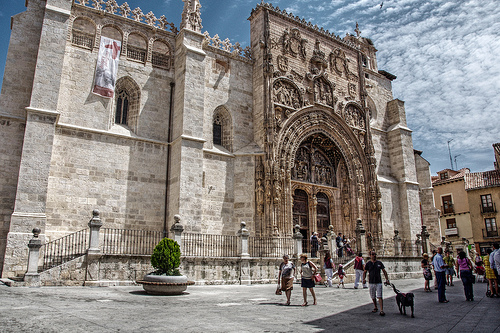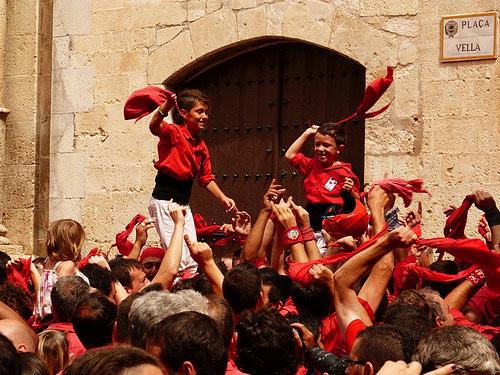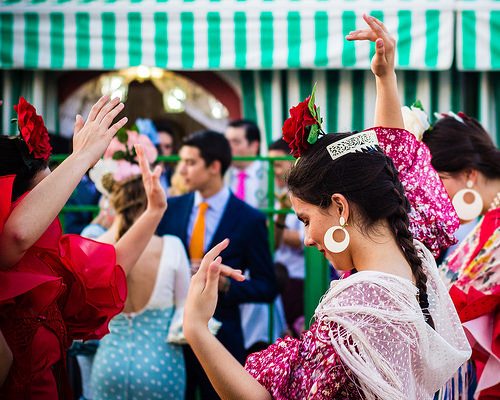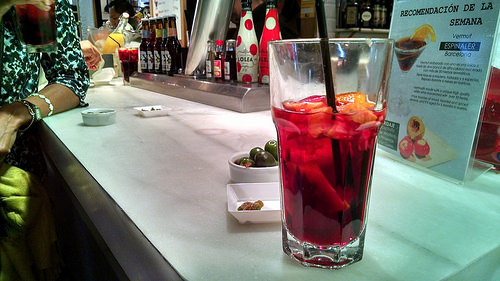At Totally Spain, we’ve been designing custom trips since the year 2000 & regularly advise clients on customs and traditions (and de-bunk the stereotypes too!) We’ve put together this guide to a typical day in Spain to help you better understand the Spanish way of life while travelling in Spain.
Typical Day in Spain – The Real Customs, Traditions & Rituals
1 A Light Breakfast First Thing – Highly Likely at 8am
Breakfast in Spain is a light affair, consisting of coffee with bread or a pastry. Fruit, yoghurt and cereals are gaining in popularity. You might have a freshly-squeezed juice or you might wait to order one out later. Remember if you work here, there is very little of the 9-5 timetable in Spain. The working day is either 8am-3pm or else 10am-2pm and 5pm-8pm. Even if you are on holiday, these times will impact on your day typical day in Spain – so pen them down somewhere.

If you don’t have a busy rush hour outside, the bell tower from the nearest church will tell you when it’s time to rise! photo credit: santiagolopezpastor Alcalá del Júcar via photopin (license)
2 Getting Dressed (Smartly – More Than Once) – Highly Likely at 9am
Whether dressing for work or leisure, smart casual is the default dress code for all – although children are often dressed very formally at weekends. And the older generation tend to dress formally also with good suits and coats worn by the men while the women have the hair-dos and are dressed very smartly. Something you many not notice is the number of times that people change their clothes in Spain especially in a small town or city. Take a typical Saturday or Sunday. One outfit is worn for popping out to the shops, maybe something else smart worn for lunch – and in the evening, something even more dressier might be worn for the evening stroll. Those going out later might even change again. If you’re planning a trip soon, read our tips about what to pack and wear in Spain.
3 Hit the Bar in the Morning (for Coffee & Something to Eat) – Highly Likely after 11am
By the time you have mastered where you are and what you are doing for the day, (unless you had a large buffet breakfast at the hotel), it’s probably time for a second coffee, out this time, with something to eat. The mid-morning snack is more filling than the first breakfast – as the bars are heaving with tasty savoury offerings including breakfast rolls stuffed with jamon serrano and an array of freshly-made tortillas. You can read all about Spanish tortilla here.
If it’s your first day in Spain, you might be asking yourself whether you need to order in Spanish. Staff working in the tourism industry usually have quite good English. As you peruse the offerings at the bar, bear in mind that you might be looking at words in Basque, Catalan or Gallego. Everybody will understand Spanish but it might be nice to say ‘hello’ and good-bye’ in the regional language – so listen to what you hear around you.

When you are up and out, it’s time to have another coffee and a juice with something to eat! photo credit: fernando garcía redondo Terraza al museo via photopin (license)
As you sip your coffee, you’ll see many locals reading newspapers. Spanish bars always offer a selection of papers for free to enjoy while having a coffee. You should probably pick up something to flick through yourself as table service is often very slow – especially when you are seated outdoors. You see, the presumption is that you are not in a rush. It’s quite normal to be waiting for 5 or 10 minutes at a café before your order is taken. And ordering the bill can take as long. Our advice is to order something at the bar if you are in a hurry.
4 Cultural/Sight-Seeing Time – Likely at Weekends – at Midday
With rituals like these, it can take Spanish holidaymakers a while to get going in Spain – which is why we always recommend our clients arrive early to the peak attractions – when they aren’t so busy. Once the morning is aired, you’ll have to stand in long lines unless you have pre-booked tickets. Check out our guide to the top monuments and museums and see why pre-booking tickets is so important. Of course, the busiest time for the museums is also in the evening when many institutions are free of charge – eg the Prado Museum in Madrid is free from 6pm-8pm on Mondays to Saturdays and on Sundays from 5pm-7pm. Whatever you do, don’t turn up to the Alhambra Granada without tickets. It’s a recipe for disaster.

You’ll be surrounded by other visitors from Spain and abroad when visiting Spain’s churches as these buildings are visited for artistic and cultural reasons more than religious. photo credit: Iglesia de Santa María via photopin (license)
5 Time for Church – Likely for Cultural Reasons/Unlikely for a Service
Church times are a little different in Spain – you might be surprised to know that services are held throughout the morning and late evening also. If you want to attend a Catholic mass, your hotel will be able to recommend a local service at a nearby church – but don’t be surprised with the low attendance. Although 70% of the Spanish identify themselves as Catholics, that does not translate down into church attendance.
That might not sit well with the image you might have of Spain – especially during Semana Santa (Eastertime) when many cities come to a standstill to accommodate the religious processions. Again, at Christmas, you’ll find lots of different customs and traditions here but they no longer involve attending religious services. Spain has become a much more secular society and the Camino de Santiago pilgrimage which was traditionally very religious is very open to believers of others faiths or no faith at all. None of this means that you shouldn’t visit churches such as the Sagrada Familia or Burgos Cathedral. Check out our guide to the best churches and cathedrals in Spain here.
NB If you’re concerned about observing your own beliefs while visiting Spain, please note that we can work with restaurants, meals and hotels that can cater to your requirements. For example, we’ve designed a great many itineraries for clients visiting Jewish heritage sights in Spain and can usually accommodate observance of the Sabbath.

Every village, town and city celebrates its fiestas in its own way. Don’t forget to ask what’s on so you can take part in the fun! photo credit: calafellvalo Nens del Vendrell 2017 (44) via photopin (license)
6 Fiesta Time- Likely During the Summer – from mid-morning (until late!)
Although you may have seen the photos from the unusual festivals such as the ‘Tomatina’ festival near Valencia where festival-goers fling ripe tomatoes at each other, most Spanish people are more likely to attend the smaller local village fiestas. Often they’ll return to where their grandparents came from and meet up with everybody else who lives away. Local fiestas are great fun for people of all ages – so always ask your hotel or tour guide whether there is something taking place nearby. It might be a display of traditional Basque sports in Bilbao, the rowing competitions throughout the North of Spain, a wine harvest festival in La Rioja or the fiestas de San Juan – Spanish bonfire night – which is celebrated all along Spain’s coastline. Unless you can plan to perfection (or you get us to plan it for you), do as the Spanish do, and head to the smaller fiestas where you are more likely to be swept along by the locals.
7 Shopping & Other Duties – Highly Likely on Saturdays – before 1pm or after 5pm
On a typical day in Spain, most shops open daily from 10am to 8pm – with family-run businesses taking a break in the middle of the day – from 1.30 to 5pm. The department stores will stay open through lunch and close at 9pm or even 10pm. Shops in the smaller cities are closed on Saturday afternoons and Sunday opening is frowned upon by most Spaniards as it is considered a day for the extended family to be together. If you want to do some shopping in Spain, make sure to do so before 1pm. If you must do any administrative tasks such as going to a bank, post office or a government building, it certainly pays to be an early bird. For more, read our guide on shopping in Spain and see our tips for gifts from Spain…

Very popular but only eaten by the Spanish at lunchtime. photo credit: BWCK Photography D4D_2663 via photopin (license)
8 A Big Meal at Lunchtime – Highly Likely – After 2pm
If you are craving a light meal around about now, you are in the wrong place. The main meal of the day, on a typical day in Spain, is served at lunchtime. If you haven’t already heard of the ‘menu del dia’ you really need to read about these superb set-price meals here. If you are only here for a few days, chances are you want to try paella. Contrary to popular belief, Spanish people rarely eat paella and usually do so at a friend’s house or at a village fiesta. NB The Spanish generally never serve paella at night so if you can, try to taste it during the middle of the day. Read our guide to the best paella here.
As you eat out in Spain, you might be surprised by how much meat the Spanish order – in all shapes and sizes – with very little carbohydrates on the side. We like to explain that it’s because people generally eat quite healthily at home, preparing salads and vegetable soups or pulse stews that are followed with a small dish of low-fat grilled meats or fish. This means that when the Spanish dine out, you’ll see the enormous steaks, platters of suckling pig, and groaning boards of ribs and chorizo, jamon and more cold cuts being ordered. Don’t panic at this point if you are not a meat-eater. It is a challenge – but not an unsurmountable one. Read our guide to eating out at a vegan or vegetarian in Spain here.
9 Nap Time – Likely at Weekends – After 3pm
This is a ritual that is still observed by babies, young children and the retired during the week on a typical day in Spain. At weekends, adults who have been working all week will opt to rest for an hour after eating – although that might involve a snooze in bed or catching 40 winks in front of the TV. The Spanish will often avoid making and taking phone calls between 3pm-5pm at weekends so as to avoid waking anybody from their nap. That doesn’t mean the nap is a long one – most people only sleep about 25 mins.
10 Time for a Stroll – The Spanish Paseo – Highly Likely Among Certain Age-Groups – After 5pm
Like the nap, this tradition isn’t going anywhere. Perhaps it’s because so many people live in apartments but it really is amazing to see extended families, couples and people on their own out for an afternoon stroll – especially at weekends. The pace is rarely fast – and the decibel levels may be high amongst family groups – but it’s a great way to get out and about. We suggest you get out and take a stroll too – take your pace from the people around you and be led along the main avenues and streets – until you need to stop for a break.

Churros are enjoyed at breakfast and as a mid-afternoon snack! photo credit: stijn Granada: breakfast with churros at Grand Café Bib Rambla via photopin (license)
11 Snacks & Treats – Likely for Those Under 12 – After 5pm
Did you know there is a meal of the day called ‘merienda’? This is when schoolkids have something to tide them over until dinnertime. It might be a ham sandwich or a roll – although it could also be a slice of sponge cake. This is one of the few items of food you’ll see consumed ‘on the go’ in Spain. The only other forms of acceptable street food in Spain include ice-cream, churros, sunflowers seeds (pipas) and roasted chestnuts. If you are really hungry around 5pm or 6pm and won’t last until 9pm, embrace the ‘merienda’. NB If you are invited to somebody’s house for merienda, prepare yourself for some coffee and cake, although you might also be offered some wine with something savoury like cured meats and cheeses. Want to know more about Spain’s mealtimes – read our guide to Just When Do You Eat in Spain?
12 Attending a Bullfight – Highly Unlikely – But If it Happens it’s in the Afternoon/Evening
Don’t come to Spain expecting to find ‘toreros’. Most small towns no longer hold bullfights and many of the larger cities only host bull-fighting festivals for a few weeks a year eg San Isidro in Madrid or the Feria de Abril in Seville or Semana Grande in Bilbao. If you want to see a bullfight, you should book tickets well in advance (or have us do that for you). Bear in mind that you will not find many other international visitors at these events – unless you are in Pamplona for the early morning bull-running. Bullfights always take place in the afternoon in Spain. If bullfighting horrifies you, you’ll find there are many people in Spain who will agree with you. It’s a topic that divides public opinion.

If you’ve had a large (and late) lunch, you’ll be more than satisfied with these pintxos for your evening meal! photo credit: Dudua Pintxoak time via photopin (license)
13 Tapas Time – Highly Likely – After 8pm
The bars in bigger cities such as Madrid and Seville now serve all-day-tapas to accommodate the demand from visitors to Spain. But in the small cities and villages, you will not be able to order tapas (or ‘raciones’ which are shared platters of food) until 8pm – and your request for tapas might be met with utter disbelief before then. If you want an authentic experience, and seek to enjoy what is pictured above, from a pintxos bar in San Sebastian, do as the locals do and wait until 8!
If you are unsure how to do tapas, one way to learn is to join a tapas tour. You won’t find any Spanish people in your group other than perhaps the guide – but we find it’s a great way to interact with others at authentic tapas bars and taste the best pintxos without having to spend hours researching locations in advance. You can also read our guide to the unwritten rules of tapas in Spain here.

The Feria de Abril in Seville – where you’ll find the whole city dressed to impress and partying from early til late! photo credit: Jantbrown Feria de Sevilla via photopin (license)
14 Time for a Flamenco Show – Unlikely (but Well Worth Seeing) – After 8pm (and often much later!)
Unless they are part of the flamenco scene, most Spanish people are very unlikely to ever go to a flamenco show. But that doesn’t mean that you shouldn’t go. They are amazing and inspiring –although they can sometimes feel less than authentic simply because they are attended by so many tourists. If you want to experience dance that is only attended by locals, perhaps you should look up the festivals such as Biennial de Flamenco, the Feria de Abril and other events where ‘sevillanas’ are danced, in Andalusia. And wherever you are in Spain, keep an ear out for village fiestas where you’ll find a ‘verbena’ dance taking place. Folk dancing is also hugely popular – with most regions have its own dances, costumes and music to enjoy. A good tourist office will be able to point you in the right direction…
15 A Night Out – Highly Likely at Weekends – After 9pm
Want an organised activity for the evening? The cinema is very popular in Spain but be aware that most movies are dubbed into Spanish. You need to see the words VO (meaning version original) beside the title of the film to see a movie with its original soundtrack. Again, going to a play can be difficult for the same reason. So what can you do? More and more museums are opening up in the evenings (especially during the Summer months) and offer guided tours with live music sessions and a cocktail – so that might be a useful way to spend your evening – if you’re not exhausted from a busy day sightseeing!

Sangria is something that is associated with Spain but rarely consumed at bars inside Spain. Stick to wine or beer or try a vermouth or a tinto de verano. photo credit: gabrilu Madrid via photopin (license)
16 A Drink Out Before Bedtime -Very Likely at Weekends – Midnight or Later!
Fancy just staying out for a few drinks? In Spain, just as with what you eat, what you drink is bound by a unwritten rules which we will attempt to document here. Unless you are in a bar beside an early morning market (or on a wine-tasting), it generally only becomes acceptable to order alcohol from 1pm – 5pm and again from 7pm until late.
Curiously for some of our visiting friends and family, it’s perfectly fine to mix beer, wine and spirits. In fact, it’s almost frowned upon if you stick with the same drink. A beer is considered fine before a meal but is not acceptable during a meal and vice versa with wine – which is rarely consumed without food.
It’s very rare to see a Spanish person drinking sangria at any time of the day. Those who want something lighter or fruitier, order a ‘tinto de verano’ or a kalimotxo (wine and coca-cola). Spirits (rum and coke, gin & tonic, mojito) are only ordered during the day after a large meal or else in the evening after 10pm.
Although the Spanish enjoy drinking and can consume what might seem like vast quantities of alcohol with food, being drunk is always frowned upon – for many reasons – and one of them is that even the youngest members of a family will be out late in the evenings at weekends.
Spain’s nightlife lasts until 3am in most places during the Summer months and a bit later if you are in the bigger cities so if you’re a night owl, you’ll find lots of people here doing the same. When you are ready to go back to your hotel, remember that hardly anybody says ‘adios’ in Spain. Try ‘hasta luego’ instead which means ‘until the next time’.

Spain’s nightlife is only just getting going when the sunflowers are grabbing the last rays of sun. photo credit: Carlos Velayos Girasoles al Atardecer. via photopin (license)
